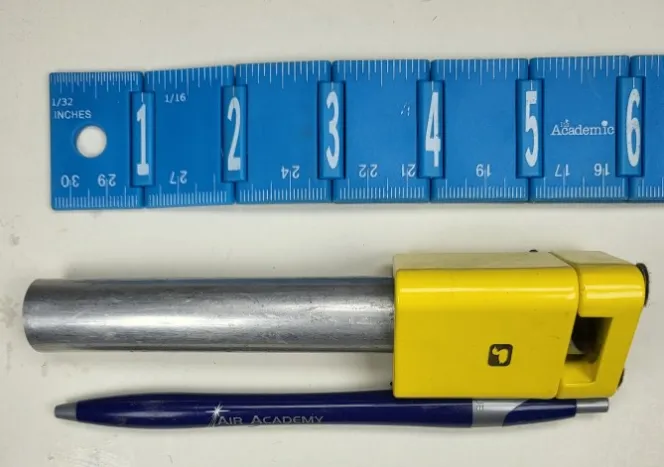A video about how to make a tube for a large Loon Zippy hair stacker and its use for Bucktail is posted on Youtube:
_______________________________________________________________________________________________________________________
Making a Homemade Aluminum Stack Tube for a Large-size Zippy Stacker
Aluminum tube used in the video: 5.5-inch, 140mm long; Outside Diameter: 0.75-inch, 19mm.
The wall thickness is 0.04-inch, 1mm, leading to an inside diameter of 0.67-inch, 17mm. The outside diameter (OD) of the tube needs to be close to 0.75 inch, 19mm, so the stack tube is loosely held when inserted in a large-size Loon hair-stacker with an internal diameter of 13/16-inch, 21mm and an internal height of 2-inches, 50mm. Keeping the tube loose in the 2-inch high stacker allows it to jiggle, wiggle and roll during the stacking process which promotes getting the hairs detached from each other and settled to the bottom. Note that other than the using a tube with an OD that allows wiggling, within reason, wall thickness and length of the tube can vary to suit the tube you have in house or the hair you intend to stack.
The stack tube is easy to make at home with just a ruler, a hacksaw, fine sandpaper, and steel wool. Measure out a 5.5-inch (140mm) length of tube-- a length will handle almost all bucktail hair lengths. Scribe an approximately 20-degree angle at the 5.5-inch mark. This angle cut opens up a port in the tube so that the hairs can be seen in the 1/4-inch (6.3mm) tall observation window of the Zippy stacker. Cut the tube to length while tilting the saw at an approximately 20-degree angle to follow the scribed line. Deburr and polish both ends of the tube using fine sandpaper and then the steel wool...and its ready to use.
Optimal Bucktail Specs: The straightest, smoothest hairs that have little or no crinkle in them will give the best result in the stacking process.
Stack Tube: Pros
1. The tube is Inexpensive and simple to make. A large Loon Zippy hair stacker is US$27 in 2023.
2. Uses a static-resistant aluminum tube. The possibility of static cling is why an aluminum tube is preferable to a plastic tube. If needed in a pinch, a plastic tube does OK in the dry climate I live in. Results may be worse in a humid climate.
3. Bundles of bucktail hair can be introduced into either end of the stack tube.
4. Theoretically, no limit on length of hair that can be stacked-- you just need to cut longer tube. The open-end design means that theoretically can stack with hair sticking out the top. However, as shown in the video and discussed below, hair can be lost out of the open tube.
5. Large internal diameter of stack tube, at about 0.675 inch (17mm OD), is an advantage in getting the individual bucktail hairs to separate during the stacking process.
6. That the stack tube is loose in the Zippy hair-stacker also promotes settling of the bucktail hairs when the hair stacker/tube assembly is held just off of vertical and jiggled, bounced and rolled along with a dead-blow style of tamping action.
7. Observation window built into the Zippy stacker can be aligned with the angled end of the stack tube so that the progress of stacking can be observed...and the process continued if the result is inadequate. The degree of stacking success-- defined as the proportion of hairs aligned at the bottom of the stack tube can assessed by first making an estimate of the number of hairs put in the tube, say 50 hairs. Then, after completing the dead-blow, jiggling and rolling cycle, look into the observation port and judge the number of hairs number of hairs aligned at the bottom of the stack tube, as you know, as this value approaches 50, the stacking success approaches 100%.
Cons:
1. The stack tube is open ended – so it is possible to slide or throw the hair out of the open top. this issue is fixed by using dead blows rather than a swinging motion to settle the hair.
2. The hinged base of Zippy stacker is held closed by magnets and that base can open while tapping or jiggling the assembled tube and Zippy base. This issue is solved by holding assembled stacker base and tube together during use.
Notes:
a. A successful stack is something like 95%+ of the bucktail aligned on the bottom of the stacker. This level of stacking can be achieved when using optimal bucktail hair, a stack tube and an appropriate dead-blow and jiggling action.
b. If a tapered tail is desired on a fly, it's better not to use a tube stacker as having hair end at different points as the end of the bucktail bundle is approached lengths leads to a gradually thinning hair bundle that gradually thins out to a point.
_______________
I suggest reading the following article to understand the hair stacking process and strategies to improve your hair stacking results.
https://globalflyfisher.com/tie-better-tying-tools/stacking-material


